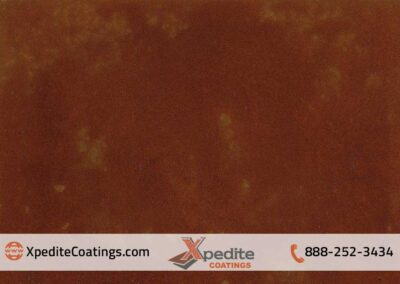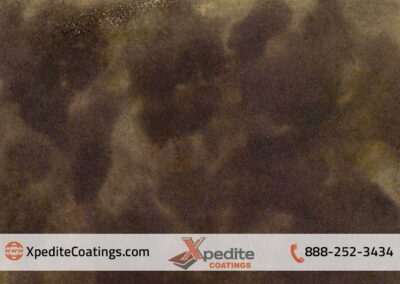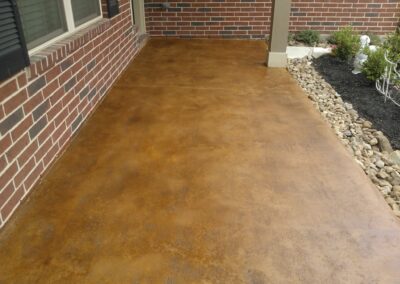Imagine the Joy of Residential Stained Concrete Floors
Experience the difference
STUNNING
SENSATIONAL
STURDY
Find out how residential
stained concrete floors can transform your living space
Enhance with concrete elegance

Are you tired of uninteresting floors, driveways, and porches that make your home look outdated and uninviting? Do you want to add color and style to your living space without spending a fortune?
Residential stained concrete floors are a great way to enhance the beauty and functionality of your home.
They are durable, easy to maintain, and environmentally friendly. They can also create stunning effects with different colors, patterns, and textures that suit your taste and style.
But don’t take our word for it.
See for yourself how residential stained concrete floors can transform your living space. We have a gallery of unique projects that we have completed for satisfied customers.
You can also read our reviews and see how happy customers are with their new floors.
Discover our stunning residential
stained concrete floor projects
Benefits of Residential Stained Concrete Floors
Do you want a more visually appealing flooring option for your home rather than plain and uninspiring concrete?
Then, upgrade to residential stained concrete floors for a beautiful and durable solution.
Stained concrete floors are incredibly low maintenance, making them an excellent option for busy homeowners. They are resistant to scratches and cracks, making them a perfect choice for outdoor spaces like driveways, patios and porches.
Stained concrete floors offer endless customization options, allowing homeowners to create a unique and personalized look for their homes.

Residential Stained Concrete FAQs
What are residential stained concrete floors?
Stained concrete floors are a popular choice for homeowners looking for an alternative to carpeted or hardwood floors. They can be designed to accompany just about any decor style and used in any room in the house.
Stained concrete is among the most prevalent floor finishes in residential new construction and renovation. They are low maintenance, stain-resistant, and easy to keep clean.
The coloring used for stained concrete cannot be achieved by any other coloring medium. Instead of producing a robust and opaque effect like paint, staining permeates the concrete.
Then, we infuse it with luminous translucent tones that vary depending on the surface and apply the techniques.
The stunning results can mimic polished marble, natural stone, stained wood, and even tanned leather.
Can old concrete be stained?
Old concrete can be stained with the proper preparation and application techniques.
However, it’s crucial to note that staining concrete is a complex process that requires expertise and specialized equipment.
Our trained technicians are skilled in assessing the condition of concrete surfaces and determining the most appropriate stain for the specific application.
Before staining, we ensure the concrete surface is clean, dry, and free of any debris or contaminants that can affect the adhesion of the stain.
We then use professional-grade equipment and techniques to apply the stain evenly and consistently.
Finally, we seal the stained concrete surface with a high-quality sealant to protect it from wear and tear, moisture, and UV damage.
Hiring a professional company ensures the staining process is done correctly and efficiently. DIY staining can result in uneven color distribution, poor adhesion, and other issues that can compromise the quality and longevity of the stained concrete surface.
How long does stain last on concrete?
The lifespan of stained concrete depends on several factors, including the quality of the stain, the application process, and the maintenance routine.
For example, some stains must be reapplied every few years to maintain their appearance.
At the same time, professional applications penetrate deeply into the concrete and last for the lifetime of the surface.
What is the difference between concrete dye and stain?
Concrete dye and stain are two different coloring agents that change concrete color. Here are the key differences between the two:
- Chemical composition: Concrete dye is a water-based solution containing tiny pigment particles that penetrate the surface of the concrete. Concrete stain is an acid-based solution containing metallic salts that react with the lime in the concrete to create a permanent color.
- Color options: Concrete dye typically comes in a wider range of colors than concrete stain, including bright and vibrant hues. Concrete stain produces more natural-looking colors and often creates a variegated or marbled effect.
- Application method: Concrete dye is usually applied using a sprayer or a brush and requires several coats to achieve the desired color. We apply concrete stain with a sprayer, brush, or roller and typically only require one or two coats.
- Durability: Concrete dye is less durable than concrete stain and may fade or wear off over time, especially if exposed to sunlight. Concrete stain penetrates deeper into the concrete and is more resistant to fading and wear.
Overall, both concrete dye and stain can be effective ways to color concrete. The choice between the two depends on the desired color, application method, and durability requirements.
What are the disadvantages of stained concrete?
While stained concrete can be an attractive and durable flooring option, there are some potential disadvantages to consider:
- Limited color options: Unlike concrete dye, which comes in a wide range of colors, stained concrete offers a more limited color palette. This may make achieving a specific color or matching existing decor more challenging.
- Acidic chemicals: If you attempt a DIY project, staining concrete involves using acidic chemicals that can be hazardous if not handled properly. You must avoid skin and eye contact and properly dispose of unused chemicals.
- Not all concrete can be stained: Staining concrete requires a porous surface to allow the stain to penetrate. Concrete that has been sealed or has a smooth surface may not be suitable for staining.
- Staining is permanent: Once the concrete has been stained, the color is permanent and cannot be easily removed or changed. It is essential to carefully consider color choices and ensure that they will complement any future changes in decor or style.
- Cost: Staining concrete can be more expensive than other flooring options, such as carpet or vinyl. However, it can be a more cost-effective alternative to high-end materials like marble or granite.
Will concrete stain peel off?
Concrete stain is permanent and won’t flake off like paint.
Stains work by penetrating the surface of the concrete and chemically reacting with the minerals in the concrete to create a permanent color.
Unlike paint, which sits on top of the surface and can peel or chip, stains become a permanent part of the concrete.
However, if the concrete surface is not adequately cleaned or there is debris, oil, or other substances, the stain may not penetrate correctly and may peel or flake off.
If the concrete surface is not sealed correctly after staining, the stain may wear off over time due to foot traffic or exposure to the elements.


















